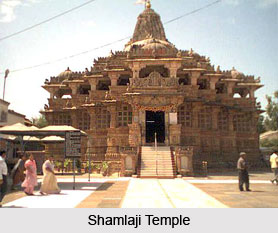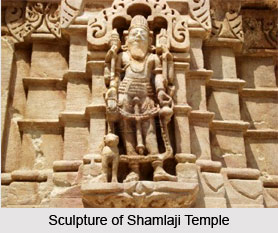 Shamlaji Temple, situated in Sabarkantha district of Gujarat, is a famous pilgrimage centre. It is considered as one of the best Vishnu temples of the state. The architectural grandeur of the temple is worth witnessing. It is intricately adorned with fine artistry. This magnificent temple stands amidst the enchanting natural beauty with high mountains and lush green forest and River Meshvo flows nearby. Behind the temple, a big lake is situated which is popular as Shyam Sarovar. The lake greatly adds to the beauty of the temple.
Shamlaji Temple, situated in Sabarkantha district of Gujarat, is a famous pilgrimage centre. It is considered as one of the best Vishnu temples of the state. The architectural grandeur of the temple is worth witnessing. It is intricately adorned with fine artistry. This magnificent temple stands amidst the enchanting natural beauty with high mountains and lush green forest and River Meshvo flows nearby. Behind the temple, a big lake is situated which is popular as Shyam Sarovar. The lake greatly adds to the beauty of the temple.
Shamlaji Temple was built during 15th century. Over time, it has undergone several renovations but care has been taken to keep its beauty and antiquity intact. The broken panels of the temple have been replaced retaining its ancient beauty. The temple is structured in Chaulukyan style of architecture which has been well preserved. It also has a vast area of gathering which is called as Uagati. It has an elegant elephant gate topped with a beautiful arch which faces the steps of main temple leading to the entrance hall. The entrance hall takes to the Garbhagriha that hosts the idol of the deity. Besides the main idol, another idol of Garuda also stands. The temple can broadly be divided into three parts namely Garbhagriha, Antaraal and Sabha Mandap. Some of the panels and floors inside the temple are profusely embellished with sculptured relief and artistic carvings.

Shamlaji temple houses a beautiful and attractive image of Gadadhar. Around the temple, huge bricks can be found scattered along with other mounds and remains of big and small temples including temples of Ranchhodraiji, Trilokinath and Kashivishvanath. These temples make the place historically very significant. Among the sculptures of the temple, the most important one is the Mahavishnu image which is also known as `Kalshi Chhokran ni Ma`. 24 avatars of Lord Vishnu have been carved on the crown of this image. Besides Shyam Sarovar a few Viharas and Stupas have been found which belong to Kshatrapa period. This suggests that the place was an important Buddhist centre.
The bases of the inner pillars are round, square or rectangle in shape. Strings of flowers are carved along the pillars in circles. Beautiful sculptures can be found on the outer walls of the temple which include images of gods and goddesses, geographical designs, men, animals and a variety of flowers. Scenes from Mahabharata, Ramayana, Bhagavad Gita and Puranas have also been depicted in the sculptures. Carvings of deities include Indrani, Chandrika, Saraswati, Ganesh, Shiva, Varun, Agni and many more. The most notable ones include the carvings of Kuber.
Two copper plates have also been discovered from the temple. The writings on the plates suggest that the temple was first renovated in the year 1782. It also revealed that the temple originally belonged to Haldhar Balram, a local merchant, and the Trivikram image of Lord Krishna (or Shamlaji) was probably first installed later.











